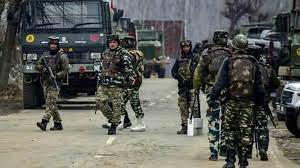In Uri, Baramulla, a terror module aiding Lashkar-e-Taiba (LeT) was uncovered, leading to the arrest of three associates. Incriminating materials, including grenades and firearms, were seized. The individuals were involved in cross-border arms smuggling under Pakistan-based handlers’ instructions, revealing the complex web that fuels terrorism. Collaborative efforts remain crucial in countering such threats.
Table of Contents
Unearthing of Terror Module and Arrests in Baramulla and Budgam
In the region of Uri, nestled within the Baramulla district of north Kashmir, security forces have succeeded in unearthing a significant terror module. This operation has led to the apprehension of three terrorist associates connected to the Lashkar-e-Taiba (LeT), a proscribed terror outfit operating in the area. The arrested individuals were found to be intricately involved in the functioning of this terror module.
Discovery of the Terror Module and Associates in Uri
The recent uncovering of a terror module in the Uri area of Baramulla marks a substantial achievement for the security forces. This module was dedicated to facilitating and supporting the activities of the LeT, a notorious extremist organization. The diligent efforts of the security forces resulted in the arrest of three key associates linked to this terror network. Their role in the module’s operations sheds light on the complexities of the terror landscape in the region.
Arrests and Recovery of Incriminating Materials
Acting on a tip-off that unveiled the existence of this terror module, security forces launched a swift operation that culminated in the arrest of a suspect individual. This person was identified as Showkat Ali Awan, hailing from the Churunda area of Uri. Subsequent to his apprehension, a search yielded the discovery of two grenades. Further questioning of Awan unveiled the names of his accomplices, Ahmad Din and Mohammad Sadeeq Khatana. The authorities, acting upon these revelations, took Din and Khatana into custody.
The investigative process led to the recovery of additional incriminating materials from the arrested individuals. Two grenades, a Chinese pistol, a pistol magazine, and four live rounds were seized from Din and Khatana. These findings underline the intention of the associates to engage in acts of violence and terrorism, underscoring the gravity of the situation.
Cross-Border Smuggling and Terrorism Facilitation
The accused individuals were deeply entrenched in the covert operations of cross-border smuggling, primarily focused on arms and ammunition. Their activities were carried out under the directive of Pakistan-based terror handlers, indicating the intricate web of external support that fuels such nefarious endeavors. The arms and ammunition obtained through these illegal means were intended for further distribution among LeT terrorists. This ominous chain of events highlights the extent to which terror groups are willing to go in order to further their destructive agenda.
The discovery of the terror module was the culmination of an intelligence-driven operation that showcased the effectiveness of timely and accurate information. Acting promptly on a tip-off, security forces apprehended a suspect individual, identified as Showkat Ali Awan. The subsequent search of his person led to the discovery of two grenades, indicative of a sinister agenda.
The investigation gained momentum as Awan provided crucial information during questioning, leading to the identification and subsequent arrest of two more individuals: Ahmad Din and Mohammad Sadeeq Khatana. The materials recovered from their possession, including grenades, a Chinese pistol, a pistol magazine, and live rounds, offered a glimpse into the intentions of the arrested individuals. Their readiness to engage in violence and terror activities is evident, raising concerns about the potential repercussions of their actions.
A notable aspect of this case is the connection between the apprehended associates and the broader network of cross-border smuggling orchestrated by Pakistan-based terror handlers. The arrested individuals were complicit in the clandestine movement of arms and ammunition, a dangerous operation that fuels the machinery of terror. The recovered weapons were intended for distribution among LeT terrorists, underscoring the seamless coordination between various elements within the terror infrastructure.
In light of these developments, the need for coordinated efforts among security agencies cannot be overstated. The complexities of modern-day terrorism necessitate vigilance, intelligence-sharing, and proactive measures. The dismantling of this terror module serves as a reminder that terrorism is a constantly evolving threat, requiring adaptable strategies to effectively counter it.
In conclusion, the exposure of a terror module in Uri, Baramulla, reveals the intricate dynamics of terrorism’s underbelly. The LeT associates’ arrests and the materials seized offer insights into their dangerous intentions. The operation highlights the broader challenges posed by cross-border terrorism and underscores the importance of collaboration among security forces to safeguard peace and stability in the region.
The recent events in the Uri area of Baramulla have shed light on the presence of a hidden terror module, operated by LeT associates. The coordinated efforts of security forces resulted in the arrests of key individuals and the confiscation of significant materials. These developments underscore the need for sustained vigilance and collaboration among security agencies to curb the menace of terrorism in the region.












